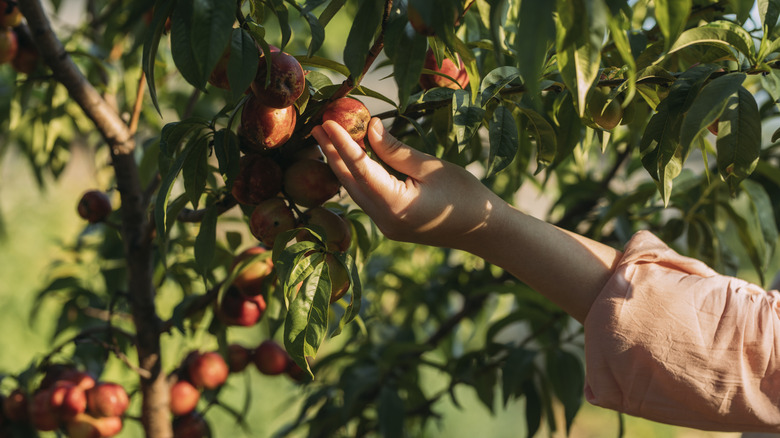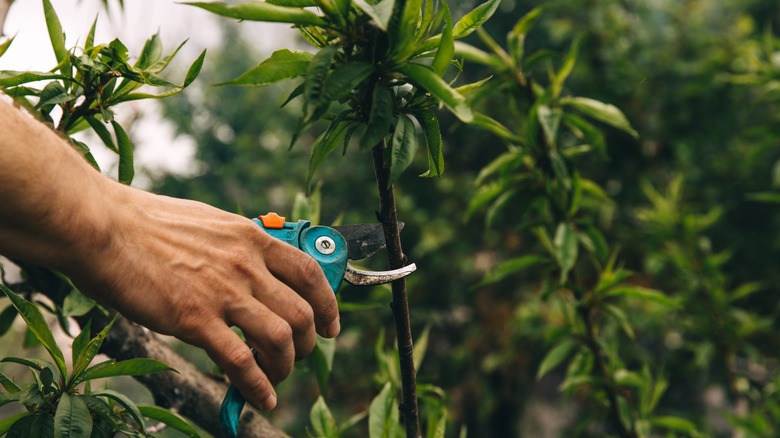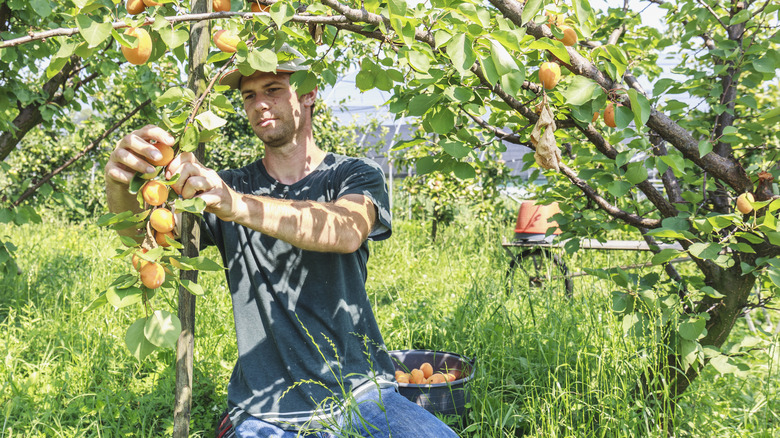Juicy Tips And Tricks To Successfully Prune A Peach Tree
Peaches (Prunus persica) are some of the juiciest and most delicious fruits available, and with a little bit of work and patience, you can even grow them in your own backyard. While it is certainly possible to successfully grow a peach tree in most parts of USDA zones 5 through 9, there are some important steps to take while pruning to ensure the best harvest. In addition to pruning your peach tree into a vase shape to give it access to plenty of light, as well as pruning at the right time of year, it's also important to make the painful choice to remove some developing fruits from the tree to allow other fruits the best opportunity to grow into perfect peaches. And, of course, always remember to use gloves and eye protection when pruning and to take good care of your tools.
One of the most important factors to keep in mind in all stages of your peach growing and pruning process is light. Not only do peach trees require full sun locations to grow well, but individual branches on the tree also require sufficient sunlight to be able to produce flowers and fruit. Pruning your tree into an open shape similar to a vase allows sunlight to reach all the branches, vastly improving flowering and fruiting. Without this step you may only end up with fruits on the highest and most difficult to reach parts of your tree.
When to prune your peach tree
There are several types of pruning your peach tree may require at different times of year. While the best time of year to prune fruit trees like peaches is late winter, if you're significantly changing or reducing the size and shape of the tree, your peach tree may also require some pruning over summer. During the late winter when your peach tree is dormant, you should focus on pruning to both reduce the tree's height, if necessary, and to remove any branches that are likely to shade the tree's interior too much. Winter is also the time to remove suckering from the roots and any unnecessary older branches that are no longer producing fruit.
Even if you've done a perfect job pruning your peach tree during the dormant season, you'll still likely need to bring out the pruning shears again during summer. June and July are perfect times to check for and remove any fast growing shoots that have grown up through the center of the tree, reducing light for your other branches. If you have a large number of branches that look like they will produce fruit, you may also want to remove a few of those branches, as peaches generally aren't as good or as large if the tree is over burdened with fruit.
Removing excess flowers and fruits
In addition to removing some branches that will produce fruit, you may also need to remove some flower buds or even young peaches to ensure the peaches that remain on the tree taste their best. As painful as this is, it does give you the best possible peach harvest. If you have already removed multiple fruiting branches, then you can allow the remaining branches to produce fruit every 4 inches or so. If you've opted not to remove some of the fruiting shoots, then it's best not to allow peaches to grow closer than 6 inches apart. On top of giving you better tasting peaches, this also prevents the branches from becoming too heavy and breaking.
While peach trees don't contain thorns or any other defenses that make them especially difficult or painful to prune, it's still important to use gloves and to protect your eyes when doing any pruning. Long sleeves are also a good idea as they guard your arms from getting scraped by branches. Don't forget to keep your pruning shears sharp, and if you're pruning multiple types of trees as part of a micro-orchard, remember to sanitize your tools in between to avoid spreading any diseases.


